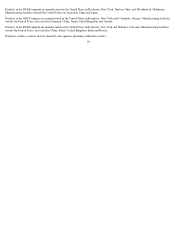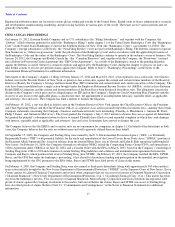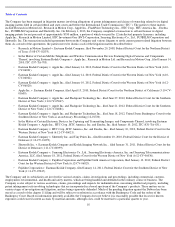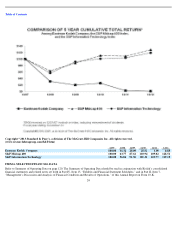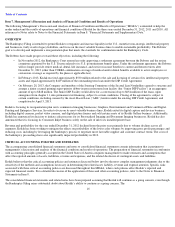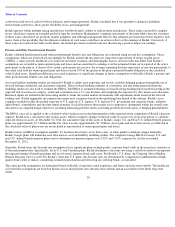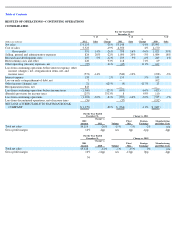Kodak 2012 Annual Report Download - page 29
Download and view the complete annual report
Please find page 29 of the 2012 Kodak annual report below. You can navigate through the pages in the report by either clicking on the pages listed below, or by using the keyword search tool below to find specific information within the annual report.
Table of Contents
consolidated financial statements do not include any adjustments related to the recoverability and classification of recorded assets or to the
amounts and classification of liabilities or any other adjustments that might be necessary should Kodak be unable to continue as a going concern.
Revenue Recognition
Kodak’s revenue transactions include sales of the following: products, equipment, software, services, integrated solutions, and intellectual
property licensing. Kodak recognizes revenue when it is realized or realizable and earned. The timing and the amount of revenue recognized
from the licensing of intellectual property depend upon a variety of factors, including the specific terms of each agreement and the nature of the
deliverables and obligations. For the sale of multiple-
element arrangements, including whereby equipment or intellectual property is combined in
a revenue generating transaction with other elements, Kodak allocates to, and recognizes revenue from, the various elements based on their
relative selling price. As of January 1, 2011, Kodak allocates to, and recognizes revenue from, the various elements of multiple-element
arrangements based on relative selling price of a deliverable, using vendor-specific objective evidence, third-party evidence, and best estimated
selling price in accordance with the selling price hierarchy.
At the time revenue is recognized, Kodak also records reductions to revenue for customer incentive programs. Such incentive programs include
cash and volume discounts, price protection, promotional, cooperative and other advertising allowances. For those incentives that require the
estimation of sales volumes or redemption rates, such as for volume rebates, Kodak uses historical experience and both internal and customer
data to estimate the sales incentive at the time revenue is recognized. In the event that the actual results of these items differ from the estimates,
adjustments to the sales incentive accruals would be recorded.
Valuation and Useful Lives of Long-Lived Assets, Including Goodwill and Intangible Assets
Kodak tests goodwill for impairment annually on September 30, and whenever events occur or circumstances change that would more likely
than not reduce the fair value of the reporting unit below its carrying amount.
Kodak tests goodwill for impairment at a level of reporting referred to as a reporting unit. A reporting unit is an operating segment or one level
below an operating segment (referred to as a component). A component of an operating segment is a reporting unit if the component constitutes
a business for which discrete financial information is available and segment management regularly reviews the operating results of that
component. When two or more components of an operating segment have similar economic characteristics, the components are aggregated and
deemed a single reporting unit. An operating segment is deemed to be a reporting unit if all of its components are similar, if none of its
components is a reporting unit, or if the segment comprises only a single component.
As a result of the change in segments that became effective as of September 30, 2012, Kodak’s reporting units changed. The Personalized and
Document Imaging segment has three reporting units: Personalized Imaging, Document Imaging and Intellectual Property. The Graphics,
Entertainment and Commercial Films segment has two reporting units: Graphics and Entertainment Imaging and Commercial Films. The Digital
Printing and Enterprise Segment has four reporting units: Digital Printing, Packaging and Functional Printing, Enterprise Services and Solutions,
and Consumer Inkjet Systems.
Prior to the September 30, 2012 change in reporting units, the only reporting units with goodwill remaining were the Consumer Digital Imaging
Group (“CDG”) and the Business Services and Solutions Group (“BSSG”). Consumer Inkjet Systems which was part of the CDG reporting unit
was transferred to the Digital Printing and Enterprise segment. Personalized Imaging and Intellectual Property, which were part of the CDG
reporting unit, are now included in the Personalized and Document Imaging Segment. Document Imaging, which was part of the BSSG
reporting unit, was transferred to the Personalized and Document Imaging segment. Workflow software which was part of BSSG was transferred
to the Graphics, Entertainment and Commercial Films segment. Enterprise Services and Solutions which was part of BSSG is included in the
Digital Printing and Enterprise Segment. Goodwill was reassigned to affected reporting units using a relative fair value allocation.
Goodwill is tested by initially comparing the fair value of each of Kodak’s reporting units to their related carrying values. If the fair value of the
reporting unit is less than its carrying value, Kodak must determine the implied fair value of the goodwill associated with that reporting unit. The
implied fair value of goodwill is determined by first allocating the fair value of the reporting unit to all of its assets and liabilities and then
computing the excess of the reporting unit’s fair value over the amounts assigned to the assets and liabilities. If the carrying value of goodwill
exceeds the implied fair value of goodwill, such excess represents the amount of goodwill impairment charge that must be recognized.
Determining the fair value of a reporting unit involves the use of significant estimates and assumptions. The fair value of a reporting unit refers
to the price that would be received to sell the unit as a whole in an orderly transaction between market participants at the measurement date.
Quoted market prices in active markets are the best evidence of fair value, however the market price of an individual equity security may not be
representative of the fair value of the reporting unit as a whole and, therefore need not be the sole measurement basis of the fair value of a
reporting unit.
26


